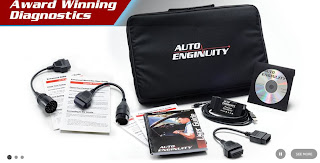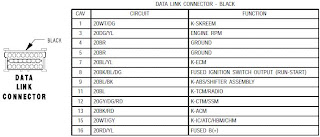The Mercedes Benz Sprinter (T1N with OM 647 engine in my case) in which the Westfalia James Cook is built on is an excellent vehicle. It has a very sophisticated drivetrain management system that is behind the industry leading performance. However it comes with a price. The price is a rather temperamental drivetrain management system and difficulties in service (especially by poorly trained technicians). Regularly there are horror stories of Sprinter owners forking out thousands of dollars to pay for repairs that should have cost hundreds because the repair service entity here in the US is too incompetent to properly diagnose the real cause.
I am fortunate to have the skills to perform the maintenance and repairs of all my vehicles. With modern vehicles managed by complex computer system performing diagnostic is next to impossible without an ODB reader capable of reading automaker's proprietary DTCs (diagnostic trouble code). The ability to read these proprietary DTCs is what set the price points of the readers ranging from those that cost under $100 to that costing thousands used by independent repair shops. Then there are the factory tools used by the dealers that is not available to the independent repair shops, let alone shade tree mechanics like me.
The makers of diagnostic tools have to license from automakers for the information to gain the engineering information needed to implement the capability. The licensing no doubt involves NDA agreements in addition to the licensing fees. There is also the high development cost too as even withing the same brand, the codes and subcodes can have different meanings on different family/model. Hence the high cost of these tools typically not in price points an average consumer willing to invest.
A kind admin of the Sprinter-Souce Forum pointed me to the Autoenginuity tool when I was troubleshoot Brunnhilde's limp home mode. I decided to do more research on it on the forum as well at the vendor site. I also spoke to a support person.
A few days ago I made my decision and order the tool. It is ~ $450 investment but I know I can recoup the cost by avoiding one dealer service visit.
For the Sprinter there are two things I needed to buy. The basic PC-based scan tool and the brand specific module for Mercedes Benz EI17.
Although I originally was waiting for a DAD to come up for sale on the Sprinter-Source forum I have since decided I can no longer wait for one. Additionally I also weighted the pros and cons of the DAD versus the Autoenginuity.
DAD:
- It was a MB factory diagnostic tool so it is capable of most of the T1N Sprinter DTCs and drivetrain management control functions (the ability to command certain actions)
- It support only the T1N generations of Sprinters and is useless for other vehicles
- It requires serial port interface and is quite temperamental with most notebook PCs with serial port low voltage interface.
- The software is quite clunky (I have seen it operate)
- It cannot be used for other vehicles
Autoenginuity:
- It costs a bit more than the DAD
- The scan tool support the generic ODB non-vendor-specific DTCs, so it can be used on any vehicle with the ODB port.
- For in depth fault diagnostic you can buy additional automaker-specific enhance modules at about $230. This give you near-OEM diagnostic capability.
- The scan tool uses USB (I believe version 2.X) interface so avoiding the problems with serial port the DAD suffers.
T1N sprinter ODB connector pin-assignments - you can see the k-line signals
the demo diagnostic screens (there are many that you can scroll through); it is unclear which model year it was taken from however so you can assume you will have all of them for your year
I asked the technical support at Autoenginuity how they handle these vendor-specific used of these pins and he told me they reader has interface to all the pins. They use a software reconfigurable electronic interface (probably something like a FPGA). After checking the demo diagnostic screens I decided to make the purchase.
Update May 20 17:07 PST:
My tool arrived via USPS. It took 10 days since my order day but auto-repair-manual who I bought from squandered 3 days.
I called Autoenginuity for a few questions on activation of the MB enhanced software and I confirmed with them it should have come with a circular connector adapter for the diagnostic port in the engine bay.
There is some of tribal knowledge one needs to have to use the software. Unlike most consumer software it is quite complex and hardly intuitive. There are many features and functions that are not applicable to your vehicle and there is no way of telling. You just have to be very good in reading between the lines from bit and pieces of information that you can get a hold of, mostly from the Sprinter-Source Forum. You really have to have some grasp of the management modules on our 2004/2005 T1N to know what you can and cannot do with it. The Sprinter management modules have gone through some major changes over the years. The main divisions are 2003 and before T1N, 2004 and later T1N, and NCV3 so the capability and availability of features vary.
To find out what the tool can monitor, and perform what activate functions will take a lot of time and is quite PITA because you have to have the engine running to explore the tool's capability. It is rather stressful when you explore a use-hostile program and you vehicle is burning a hole in the ozone layer. It is hardly WYSIWYG as you would expect with diagnostic programs that are developed under very tight budget.
Even the technical support guy you call up cannot tell you most of the time what you can and cannot do with your vehicle. They first thing he will say is refer to the service manual. Most of these limitations are not unique to this tool. From the time I was researching the tool I made 4 phone calls to Autoenginuity to ask questions. Each time I received live support so it is a breath of fresh air in my experience of seeking product technical support help.
The no so obvious for a new user of this tool for T1N Sprinters are:
1) Stick to the Live Data Grid and the Diagnostic Trouble Code tabs. Do not use the O2 Sensors tab. I was eagar to see some live data parameters and all I saw was zeros in Live Data Meter and Live Data Graph tabs.
2) To invoke the activation capabilities you have to right click anywhere on the menu bar and select activation. What confuse me was the tech support told me to right click on the Help on the menu bar. Only later I realize Help has nothing to do with this onther than it is along the menu bar that right clicking will bring up the choice. For anyone new to the tool you would likely assume it is for activating the software you purchased.
Seeing how the parameters are displayed and how the user interface I can just imagine the persons that develop the vehicle specific enhanced capability using the reams of dry reading specifications likely in English poorly translated from a foreign language (German in the case of MB).
I am quite eager to find out the what activate functions this tool supports compared to ones that the DAD does. For example, selectively shut off one injector for trouble-shooting. The activate functions must be used with a lot of caution and deliberations.
To be more self-sufficient I would also need to purchase this Sprinter Fault Code Guide that is for T1N specifically. It is quite expensive for what it is but you have to pay to play for the proprietary information. You can see for some MB-proprietary codes, the same code can mean different thing in different models. e.g. Different meaning for Sprinter from S-class.




No comments:
Post a Comment